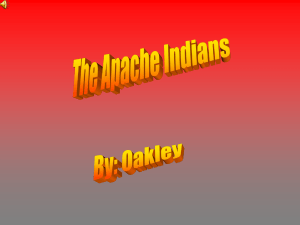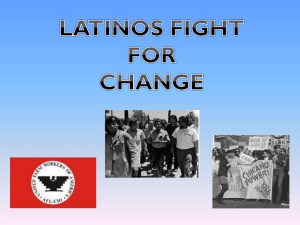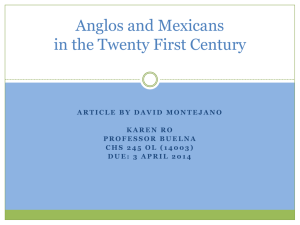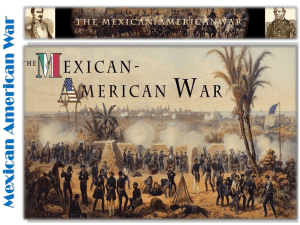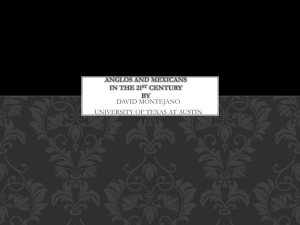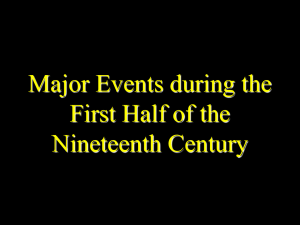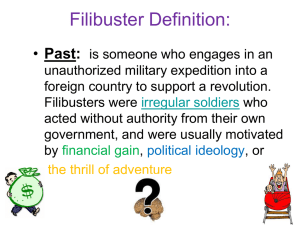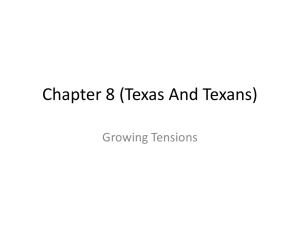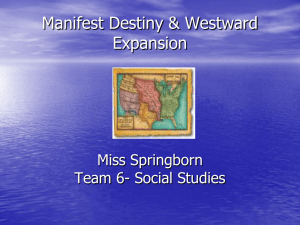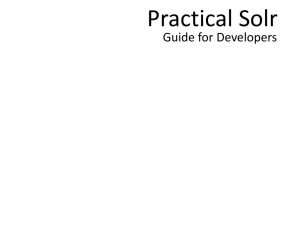PPT
advertisement
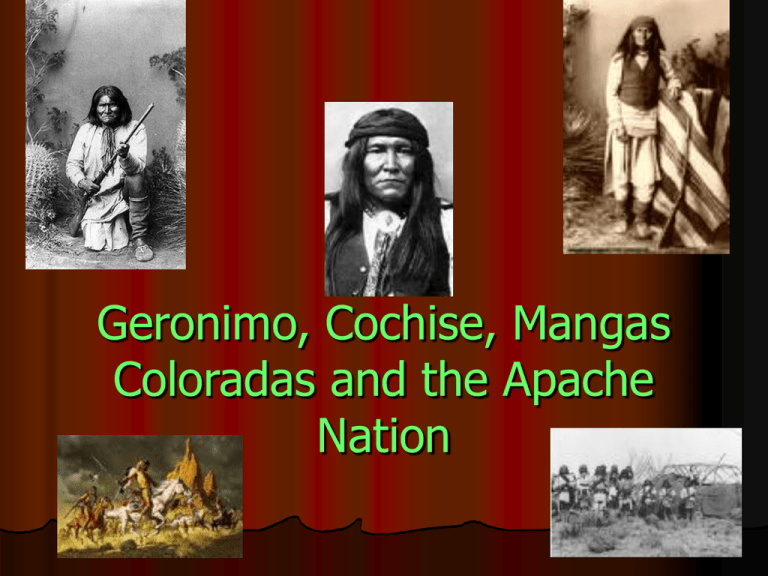
Geronimo, Cochise, Mangas Coloradas and the Apache Nation 1 Mangas Coloradas or Dasoda-hae (known as Red Sleeves) (c.1793 – January 18, 1863) was an Apache tribal chief and a member of the Eastern Chiricahua nation, whose homeland stretched west from the Rio Grande to include most of what is present-day southwestern New Mexico 2 He is regarded by many historians to be one of the most important Native American and Apache leaders of the 19th century due to his fighting achievements against White intruders from the United States. The name Mangas Coloradas was given to him by Mexicans 3 During the decades of the 1820s and 1830s, the Apaches' main enemy were the Mexicans, who had won their independence from Spain in 1821. By 1835 Mexico had placed a bounty on Apache scalps. After Juan José Compas, the leader of the Mimbreno Apaches, was killed for bounty money in 1837, Mangas became a war leader and began a series of retaliatory raids against the Mexicans. 4 In 1846, when the United States went to war with Mexico, the Apache Nation promised U.S. soldiers safe passage through Apache lands. Once the U.S. occupied New Mexico in 1846, Mangas Coloradas signed a peace treaty, respecting them as conquerors of the hated Mexican enemy. 5 An uneasy peace between the Apache and the United States lasted until an influx of gold miners into New Mexico's Pinos Altos Mountains led to open conflict. Mangas was personally attacked by a group of White miners who tied him to a tree and severely flogged him. 6 December, 1860, thirty miners launched a surprise attack on an encampment of Bedonkohes on the west bank of the Mimbres River. "...killed four Indians, wounded others, and captured thirteen women and children." Shortly after that, Mangas began raids against U.S. citizens and their property. 7 Mangas Coloradas' daughter Dos-Teh-Seh married Cochise, principal chief of the Chokonen Apache. In early February 1861, US Army Lieutenant George N. Bascom, apparently without orders, lured Cochise, his family and several warriors into a trap at Apache Pass, southeastern Arizona. 8 Cochise managed to escape, but his family and warriors remained in custody. Negotiations were unsuccessful and fighting erupted. This incident, known as the “Bascom Affair," ended with Cochise’s brother and five other warriors being hanged by Bascom. 9 Later that year, Mangas and Cochise struck an alliance, agreeing to drive all Americans out of Apache territory. They were joined in their effort by Juh and Geronimo. Although the goal was never achieved, the White population in Apache territory was greatly reduced for a few years during the Civil War, after federal troops had been withdrawn to the east. 10 In the summer of 1862, after recovering from a bullet wound in the chest, Mangas Coloradas met with an intermediary to call for peace. In January 1863, he decided to meet with U.S. military leaders at Fort McLane, in southwestern New Mexico. Mangas arrived under a flag of truce to meet with Brigadier General Joseph Rodman West, an officer of the California militia 11 Armed soldiers took Mangas into custody. West allegedly gave an execution order to the sentries. “Men, that old murderer has got away from every soldier command and has left a trail of blood for 500 miles on the old stage line. I want him dead or alive tomorrow morning, do you understand? I want him dead. That night Mangas was tortured, shot and killed "trying to escape." 12 The following day, U.S. soldiers cut off his head, boiled it and sent the skull to Orson Squire Fowler, a phrenologist in New York City. The murder and mutilation of Mangas' body only increased the hostility between Apaches and the United States, with more or less constant war continuing for nearly another 25 years. 13 Cochise Cochise (or "Cheis") (c. 1805–June 8, 1874) was one of the most famous Apache leaders to resist intrusions by Americans during the 19th century. He was described as a large man with a muscular frame, classical features, and long black hair which he wore in traditional Apache style. He was about 5'10" tall and weighed about 175 lbs. In his own language, his name "Cheis" meant "having the quality or strength of oak 14 Cochise and the Chokonen-Chiricahua lived in the area that is now the northern Mexican region of Sonora, New Mexico, and Arizona. As Spain and later Mexico attempted to gain dominion over their lands, the various Chiricahua groups became increasingly resistant. 15 Various Chiricahua bands resumed traditional raiding to acquire what they needed after the Mexicans no longer made provisions for them (in the 1830s) As a result, the Mexican government began a series of military operations in order to either capture or neutralize the Chiricahuas, but they were fought to a standstill by the Apaches. As part of their attempts at controlling the Chiricahuas particularly, Mexican forces, often with the help of American and Native American mercenaries, began to kill Apache civilians, many times paying bounties for their scalps. . 16 Cochise's father was one of these victims. This hardened Cochise's resolve and gave the Chiricahuas more rationale for vengeance. Mexican forces did capture Cochise at one point in 1848 during an Apache raid on Fronteras, Sonora, but they exchanged him for nearly a dozen Mexican prisoners. 17 For Cochise, the Americans held nothing sacred and had violated the rules of war by capturing and killing Mangas Coloradas during a parley session. Cochise and the Apaches continued their raids against American and Mexican settlements and military positions throughout the 1860s. Blue dot represents where US Army Lieutenant George N. Bascom met Apache leader Cochise in Apache Pass on February 5, 1861 18 Following various skirmishes, Cochise and his men were gradually driven into the Dragoon Mountains but were nevertheless able to use the mountains for cover and as a base from which to continue attacks against the white settlements. 19 Cochise managed to evade capture and continued his raids against white settlements and travelers until 1872. A treaty was finally negotiated by General Oliver O. Howard, with the help of Tom Jefferds who was Cochise's only white friend 20 After making peace, Cochise retired to his new reservation, with his friend Jeffords as agent, where he died of natural causes (probably abdominal cancer) in 1874. He was buried in the rocks above one of his favorite camps in Arizona's Dragoon Mountains, now called Cochise Stronghold. Only his people and Tom Jeffords knew the exact location of his resting place, and they took the secret to their graves. 21 Cochise Stronghold, Dragoon Mountains, southeastern Arizona. Geronimo (June 16, 1829 – February 17, 1909) was a prominent Native American leader of the Chiricahua who fought against Mexico and the United States for their expansion into Apache tribal lands for several decades during the Apache Wars. 22 Allegedly "Geronimo" was the name given to him during a Mexican incident, but his real name was Goyaałé from the Chiricahua Language meaning "one who yawns"; often spelled Goyathlay Goyahkla was born to the band of the Apache, near Turkey Creek, a tributary of the Gila River in the modern-day state of NewMexico 23 On March 6, 1858, a company of 400 Mexican soldiers from Sonora led by Colonel José María Carrasco attacked Goyahkla's camp outside Janos while the men were in town trading. Among those killed were Goyahkla's wife, his children, and his mother. His chief, Mangas Coloradas, sent him to Cochise's band for help in revenge against the Mexicans. 24 Allegedly it was during this incident that the name Geronimo came about. This appellation stemmed from a battle in which, ignoring a deadly hail of bullets, he repeatedly attacked Mexican soldiers with a knife, causing them to utter appeals to Saint Jerome ("Jeronimo!"). Americans heard this and thought his name was Geronimo, and the name stuck 25 Apache raids on Mexican villages were so numerous and brutal that no area was safe. While Geronimo said he was never a chief, he was a military leader. As a Chiricahua Apache, this meant he was one of many people with special spiritual insights and abilities known to Apache people as "Power" Among these were the ability to walk without leaving tracks; the abilities now known as telekinesis and telepathy; and the ability to survive gunshot 26 Though outnumbered, Geronimo fought against both Mexican and United States troops and became famous for his daring exploits and numerous escapes from capture from 1858 to 1886. At the end of his military career, he led a small band of 36 men, women, and children. They evaded thousands of Mexican and American troops for over a year, making him the most famous Native American of the time and earning him the title of the "worst Indian who ever lived" among white settlers 27 "About two weeks after the escape there was a report of a family massacred near Silver City; one girl was taken alive and hanged from a meat hook jammed under the base of her skull." His band was one of the last major forces of independent Native American warriors who refused to acknowledge the United States occupation of the American West. 28 In 1886, General Nelson A. Miles selected Captain Henry Lawton, in command of B Troop, 4th Cavalry, at Ft. Huachuca and First Lieutenant Charles B. Gatewood to lead the expedition that captured Geronimo Completely worn out, the little band of Apaches returned to the U.S. with Lawton and officially surrendered to General Miles on September 4, 1886 at Skeleton Canyon Arizona 29 When Geronimo surrendered he had in his possession a Winchester Model 1876 lever action rifle with a silver-washed barrel and receiver. It is on display at the United States Military Academy, West Point New York. Additionally he had a Colt Single Action Army revolver with a nickel finish and ivory stocks and a Sheffield Bowie Knife with a dagger type of blade and stag handle made by George Wostenholm in an elaborate silver-studded holster and cartridge belt. The revolver, rig, and knife are on display at the Fort Sill museum 30 Capture Geronimo and other Apaches, including the Apache scouts who had helped the army track him down, were sent as prisoners to Fort Pickens, in Pensacola, Florida, and his family was sent to Fort Marion. They were reunited in May 1887, when they were transferred to Mount Vernon Barracks in Alabama for seven years. In 1894, they were moved to Fort Sill, Oklahoma. In his old age, Geronimo became a celebrity. He appeared at fairs, including the 1904 World’s Fair in St Louis, where he reportedly rode a ferris wheel and sold souvenirs and photographs of himself. However, he was not allowed to return to the land of his birth. He rode in President Theodore Roosevelt’s 1905 inaugural parade 31 Death In February 1909, Geronimo was thrown from his horse while riding home, and had to lie in the cold all night before a friend found him extremely ill. He died of pneumonia on February 17, 1909, as a prisoner of the United States at Fort Sill, Oklahoma. On his deathbed, he confessed to his nephew that he regretted his decision to surrender. He was buried at Fort Sill in the Apache Indian Prisoner of War Cemetery 32
